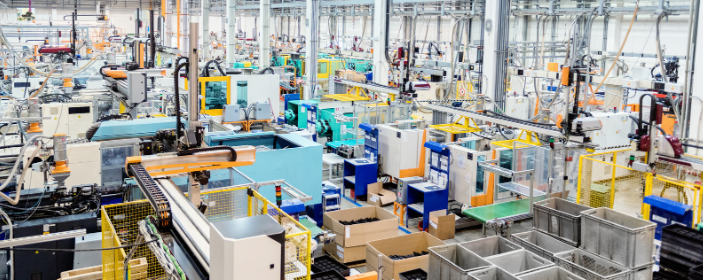
The manufacturing sector is not out of the woods just yet
The global Purchasing Managers’ Index (PMI) remains under 50, indicating a contraction of the sector. However, there are signs that the outlook is improving, and that the worst of the manufacturing recession could be behind us. MNCs should begin anticipating a recovery in activity in major markets such as Europe and the US, as well as in Southeast Asia, which is poised to benefit from China’s reopening. Still, these will likely not recover until Q2/Q3; in the meantime, MNCs should capture opportunities found in pockets of resilience, such as India and the oil-exporting Middle East. Where possible, MNCs should capitalize on lower commodity spot prices by locking in energy contracts. Firms selling to manufacturers should continue to explore options to lower upfront costs for customers through subscription models, deferred payment options, leasing, and other tools. While confidence is improving, manufacturing customers may be hesitant to make significant commitments just yet, even if they are starting to see a gradual improvement in conditions.
Overview
A major change since our last commentary has been the sudden and unexpected rollback of China’s zero-COVID policy. In the short term, the impact of the policy change on the Chinese manufacturing sector has been mixed: while the fall in new orders showed signs of slowing, hinting at improved confidence, the sector is hobbled by staff absences, themselves a product of the rapid spread of COVID-19 among the population. Over the medium term, however, conditions should improve as workers acquire immunity and the demand outlook becomes more certain.
The rest of Asia presents a mixed picture. ASEAN, until recently one of the few bright spots on the global manufacturing landscape, is now fractured between high performers (e.g., Thailand and the Philippines) and laggards (e.g., Malaysia and Vietnam). Falling global demand is weighing on Taiwan and Japan, both of which continue to suffer from the depressed demand for electronics. Finally, India remains the star of the show in the region, propelled by robust domestic demand that has allowed manufacturers to pass on price increases. However, demand from abroad is starting to lag and could be a drag on India’s manufacturing sector in the coming months as global economic activity slows.
In the US, the rate of contraction slowed slightly, but conditions remain weak by historical standards; falls in new orders, both domestic and international, indicate continued hesitancy and uncertainty among businesses. Slower activity has translated to slower job creation but has allowed manufacturers to clear their backlogs. Meanwhile, positive economic news and hopes of a soft landing have pushed the degree of medium-term optimism to an eight-month high, although the prospect of further monetary tightening continues to weigh on expectations.
The eurozone’s manufacturing sector contracted for the eighth consecutive month, but showed tentative signs of improvement, with some individual countries, such as France and Italy, even posting slight expansions. Among manufacturers, the feeling is that the worst is behind them, in large part thanks to the improving energy situation—similar to the sentiment in Eastern Europe. In the UK, operating conditions were trickier than in the rest of Europe, partly due to country-specific factors such as Brexit disruptions and industrial action.
Elsewhere, the Russian manufacturing sector is being boosted by sanctions-imposed import substitution. In MENA, oil exporters continue to perform much better than their commodity-importing peers, with the exception of Qatar, which is reeling from a post-World Cup construction hangover. Finally, the highly unstable electricity situation in South Africa is proving a drag on performance, compounded by a situation of high inflation and low demand.
Our View
The bad news is conditions in the global manufacturing sector are still very poor: the four major manufacturing economies (the US, China, the EU, and Japan) are all in a state of contraction and have been for the last few months. High and rising interest rates and sluggish global demand continue to suppress activity, and both output and new orders remain low by historical standards.
The good news, however, is that there is light at the end of the tunnel. In particular, the reopening of China is cause for optimism, particularly among Asian manufacturers, although we expect demand for goods to recover more slowly than for services among Chinese consumers. Overall, while demand remains subdued, there are signs that it is starting to pick up in anticipation of the recovery later in the year.
On the input cost side, manufacturers around the world are enjoying a slight respite from the levels seen in 2022, notably when it comes to oil and gas. This has translated into lower levels of price growth, which bodes well for goods inflation globally. Still, it will likely not be plain sailing on the input cost front: higher demand resulting from China’s reopening will put upward pressure on commodity prices, notably around H2.
At FrontierView, our mission is to help our clients grow and win in their most important markets. We are excited to share that FiscalNote, a leading technology provider of global policy and market intelligence has acquired FrontierView. We will continue to cover issues and topics driving growth in your business, while fully leveraging FiscalNote’s portfolio within the global risk, ESG, and geopolitical advisory product suite.
Subscribe to our weekly newsletter The Lens published by our Global Economics and Scenarios team which highlights high-impact developments and trends for business professionals. For full access to our offerings, start your free trial today and download our complimentary mobile app, available on iOS and Android.

